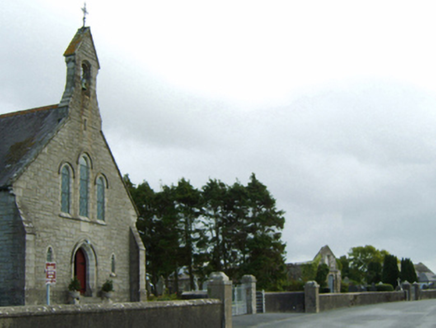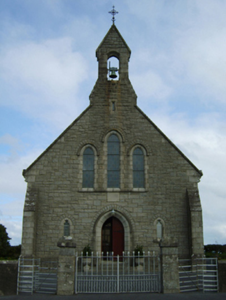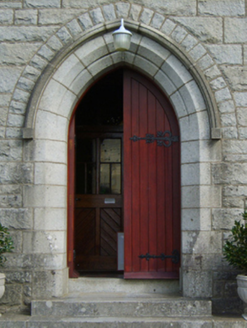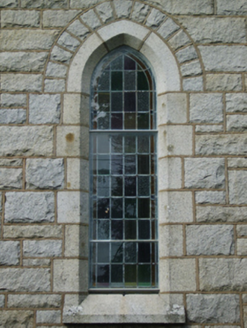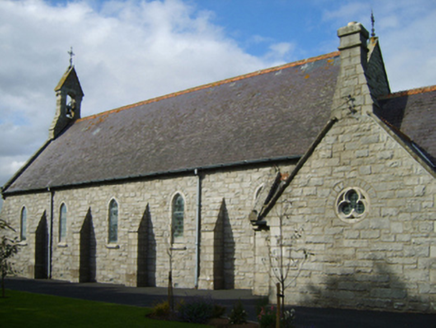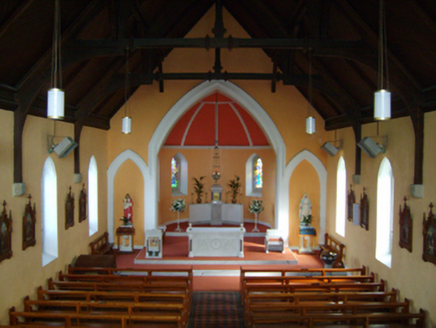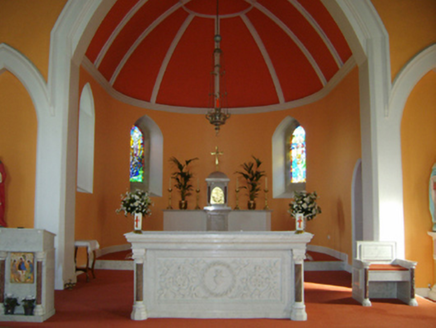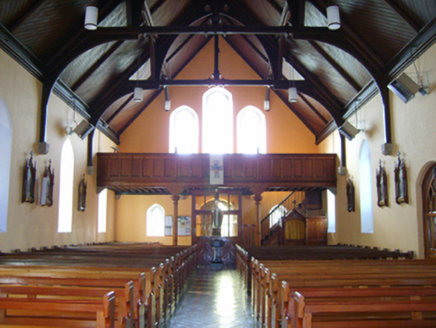Survey Data
Reg No
15700721
Rating
Regional
Categories of Special Interest
Architectural, Artistic, Historical, Social, Technical
Original Use
Church/chapel
In Use As
Church/chapel
Date
1880 - 1890
Coordinates
322398, 165020
Date Recorded
27/09/2007
Date Updated
--/--/--
Description
Detached six-bay double-height Catholic church, built 1884-5; opened 1885, on a rectangular plan comprising five-bay double-height nave opening into single-bay double-height apse (north) on a bowed plan. Renovated, 1974, with sanctuary reordered. Pitched slate roof; half-conical slate roof (north), perforated crested terracotta ridge tiles, cut-granite coping to gables on roll moulded gabled kneelers including cut-granite coping to gable to entrance (south) front on roll moulded gabled kneelers with buttressed gabled bellcote to apex framing cast-bronze bell, and cast-iron rainwater goods on exposed timber rafters retaining cast-iron square profile downpipes. Part repointed tuck pointed snecked rock faced granite walls with granite ashlar buttresses including granite ashlar buttresses to corners having cut-granite "slated" coping. Lancet window openings with cut-granite sills, and cut-granite block-and-start surrounds having chamfered reveals framing storm glazing over fixed-pane fittings having stained glass margins centred on square glazing bars. Lancet window openings (north) with cut-granite sills, and cut-granite block-and-start surrounds having chamfered reveals framing storm glazing over fixed-pane fittings having leaded stained glass panels. Pointed-arch door opening to entrance (south) front approached by flight of three cut-granite steps, cut-granite block-and-start surround having chamfered reveals with hood moulding on monolithic label stops framing timber boarded double doors. Lancet "Trinity Window" (gable) with cut-granite sills, and cut-granite block-and-start surrounds having chamfered reveals with hood mouldings on monolithic label stops framing storm glazing over fixed-pane fittings having stained glass margins centred on square glazing bars. Full-height interior open into roof with timber panelled choir gallery (south) on octagonal pillars, tessellated glazed "quarry tile" central aisle between roll-topped timber pews, paired Gothic-style timber stations between frosted glass windows, exposed Hammerbeam timber roof construction on cut-granite beaded corbels with wind braced diagonal timber boarded ceiling in carved timber frame on carved timber cornice, and carpeted stepped dais to sanctuary (east) reordered, 1974, with pointed-arch chancel arch framing stained glass memorial windows (----) centred on tabernacle. Set back from line of road with granite ashlar piers to perimeter having stepped capping supporting trefoil-detailed wrought iron double gates.
Appraisal
A church erected to a design by William Hague (1836-99) of Westland Row, Dublin (DIA), representing an important component of the later nineteenth-century built heritage of north County Wexford with the architectural value of the composition, one interpretable as a reduction of the Hague-designed Saint Columcille's Catholic Church (1896-1902) in County Westmeath, confirmed by such attributes as the rectilinear plan form, aligned along a liturgically-incorrect axis; the rock faced surface finish offset by sheer granite dressings demonstrating good quality workmanship; the slender profile of the openings underpinning a "medieval" Hard Gothic theme; and the handsome bellcote embellishing the roofline as a picturesque eye-catcher in the landscape. Having been well maintained, the elementary form and massing survive intact together with substantial quantities of the original fabric, both to the exterior and to the interior reordered (1974) in accordance with the liturgical reforms sanctioned by the Second Ecumenical Council of the Vatican (1962-5) where contemporary joinery; and vibrant stained glass, all highlight the artistic potential of the composition: meanwhile, an exposed timber roof construction pinpoints the engineering or technical dexterity of a church forming part of a self-contained group alongside an adjacent chapel (see 15700722) with the resulting ecclesiastical ensemble making a pleasing visual statement in a rural village street scene.
